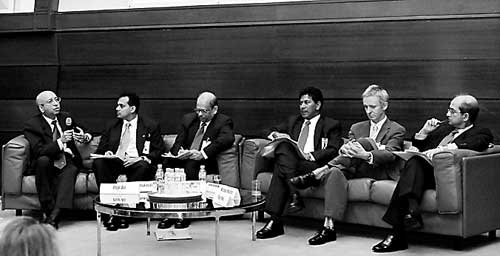
Sri Lanka needs inclusive growth strategies
South Asia is in a most remarkable period of time with outstanding economic growth and sustained development with a GDP closing on 7-8 percent, becoming the most watched region for launching of new products, new acquisitions and joint ventures for all global companies. However, at last week’s Economic Summit on Inclusive Growth and Poverty Reduction in the New Asia and Pacific in Manila, Philippines where high level government officials, donor agencies, academics and business leaders met a key area emphasized was the quality of growth. Rohantha Athukorala, Director of Economic Affairs of the Government’s Peace Secretariat who took part, said it was agreed that economic growth must reflect in more consumers in country being empowered to make decisions on how economic growth must take shape in their community. This approach will result in a greater distribution of the economic growth seen in a country which in turn can have a business spin of greater penetration of an organizations products and services. The way forward debated, was that a country must move away from pro poor social welfare based poverty reduction process to a more inclusive growth based poverty reduction strategy. The definition of Inclusive growth agreed at the forum in Manila, was that when a system allows all members of a society to participate and contribute to the growth process on an equal basis regardless of their individual circumstances and that the opportunities created is accessible to all in the country. The difference in the two approaches is that in inclusive growth, the people are empowered to take decisions based on the overall skill they have been trained in, the availability of micro financing at concessionary rates, technology transfer and driving entrepreneurship at the most micro level in a country. In Sri Lanka it can be the ‘Village’ or the Divisional secretariat, said Athukorala. In other words macro policy changes will have to be introduced so that education, health and even in the case of infrastructure development, a villager or a Divisional Secretary will get involved in the planning, implementation and evaluation process. From a multilateral agencies’ point of view like the Asian Development Bank (ADB) it will be a drastic change where one moves away from being a lender of funds for large infrastructure projects to, becoming more involved in the economic development process in a country. This means these institutions will have to power themselves with new skills and capabilities to this new role they have to play in a country. Sri Lanka – Best in the Class Athukorala said Sri Lanka’s growth has outperformed countries in the region in overall poverty dropping to 22.7 percent and on the key criteria of those in the poverty below 1 US dollar a day and 2 US dollars a day Sri Lanka is way past all the countries in the South Asian region. However, in addition to the disparities between the Western Province and the rest of the country, the slow pace of poverty reduction in Sri Lanka is linked to rising inequality among income groups. Average per capita consumption grew by 50 per cent for the richest consumption quintile but on 2 per cent for the poorest quintile. The Gini Coefficient of per capita consumption in Sri Lanka increased at an annual rate of 2 per cent, much higher than for East Asian comparator countries with the exemption of China which are some worrying indicators that needs to be addressed. Future |
|
||
| || Front
Page | News
| Editorial
| Columns
| Sports
| Plus
| Financial
Times | International
| Mirror
| TV
Times | Funday Times || |
| |
Reproduction of articles permitted when used without any alterations to contents and the source. |
© Copyright
2007 | Wijeya
Newspapers Ltd.Colombo. Sri Lanka. All Rights Reserved. |
